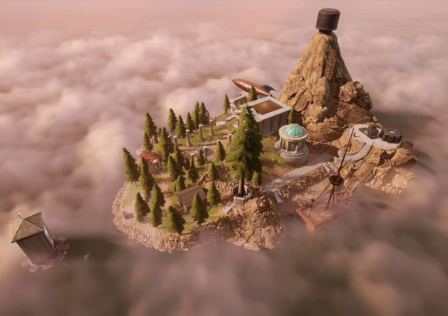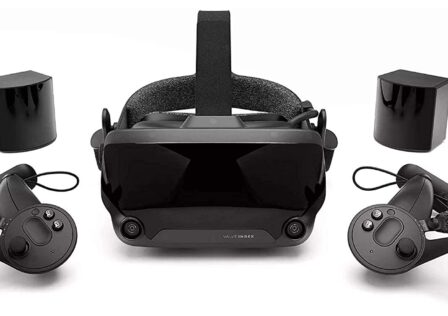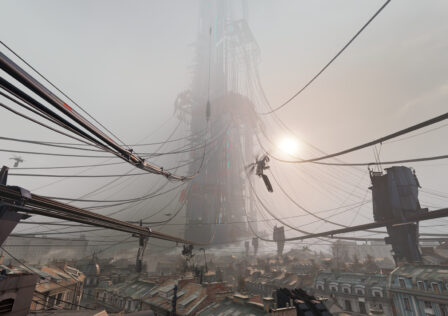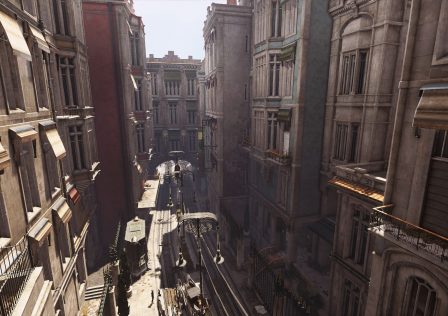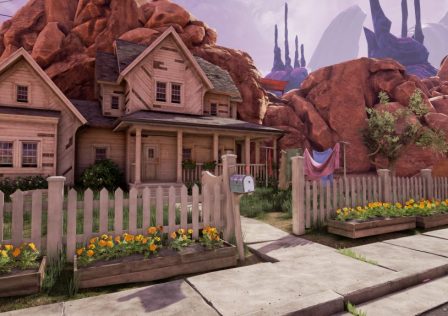Myst was a 1993 classic and the best selling PC game until 2002. It is on probably every platform you can think of, it has been remade several times before and now we have another remake. There is a Myst for every graphics generation.
So why has it been remade again? The distinguishing factor for this remake is VR, which is a natural fit for all the games in the Myst series. Yet this remake isn’t a VR exclusive – it was a timed Oculus exclusive (think of it as Oculus users beta testing it), but now it is available for SteamVR and also just normal PC gaming (Windows and Mac but not Linux). This remake also contains a randomized puzzle mode, something that is a nice benefit for those who played Myst previously.
The original Myst used pre-rendered environments (renderings), and it is presented in such a way that makes it look like the player teleports through them. This is how a detailed first person environment had to be done in 1993. It was a pioneer both in technology and in game design, for both puzzle and adventure games. The game was first remastered in 2000, being a higher fidelity version of the original 2D game. That same year brought the first 3D remake that plays like a normal first person game we all know today, and then in 2014 it was remade again on Unity engine, combining both the original 2D style with an updated 3D style.
Is this the definitive edition of Myst? How does the game’s design hold up today? Let’s find out.
Writing and Gameplay
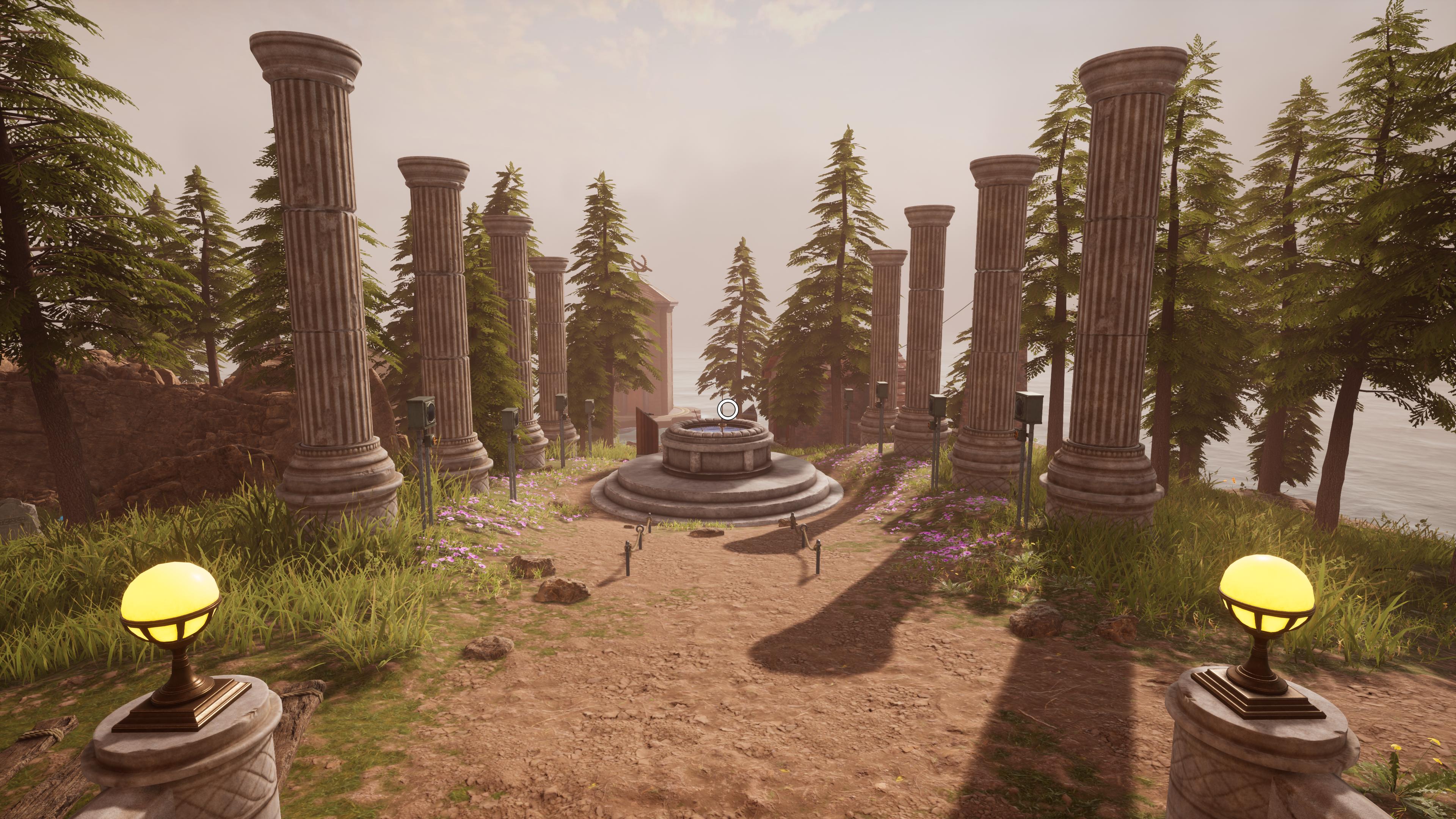
For those who never played Myst, it is a breathtaking story driven puzzle adventure game that spawned a massive franchise including Riven, Myst 3-5, and Uru: Ages Beyond Myst. It also spawned several novels, and even more was planned back in the day but didn’t come to fruition.
Throughout Myst and the rest of the franchise, you will travel between unique worlds through what appear to be magical books (linking books), written in a special language in a process known as “The Art.” Details about The Art are better explored in the novels, Myst serves as your introduction to this universe, or better yet multiverse. Needless to say, The Art introduces what would be considered blasphemous concepts about creation, and can lead to people believing that they’re gods. You’ll get a glimpse of these themes in Myst, and more in other material in the franchise (most of all the novels).
The game takes place on Myst island, a central hub. Access to these different worlds, known as Ages, is accomplished by solving puzzles. There’s no hand holding whatsoever in this game, so it isn’t always immediately clear how a puzzle works or how it must be solved, the opposite of some other puzzle games like The Talos Principle. Like many other fearless, classic PC games, Myst drops you into its world and leaves you on your own to advance and finish the game. The most guidance you get from the start is a handwritten note, which in this remake is placed on a rock right next to a path so it is difficult to miss.
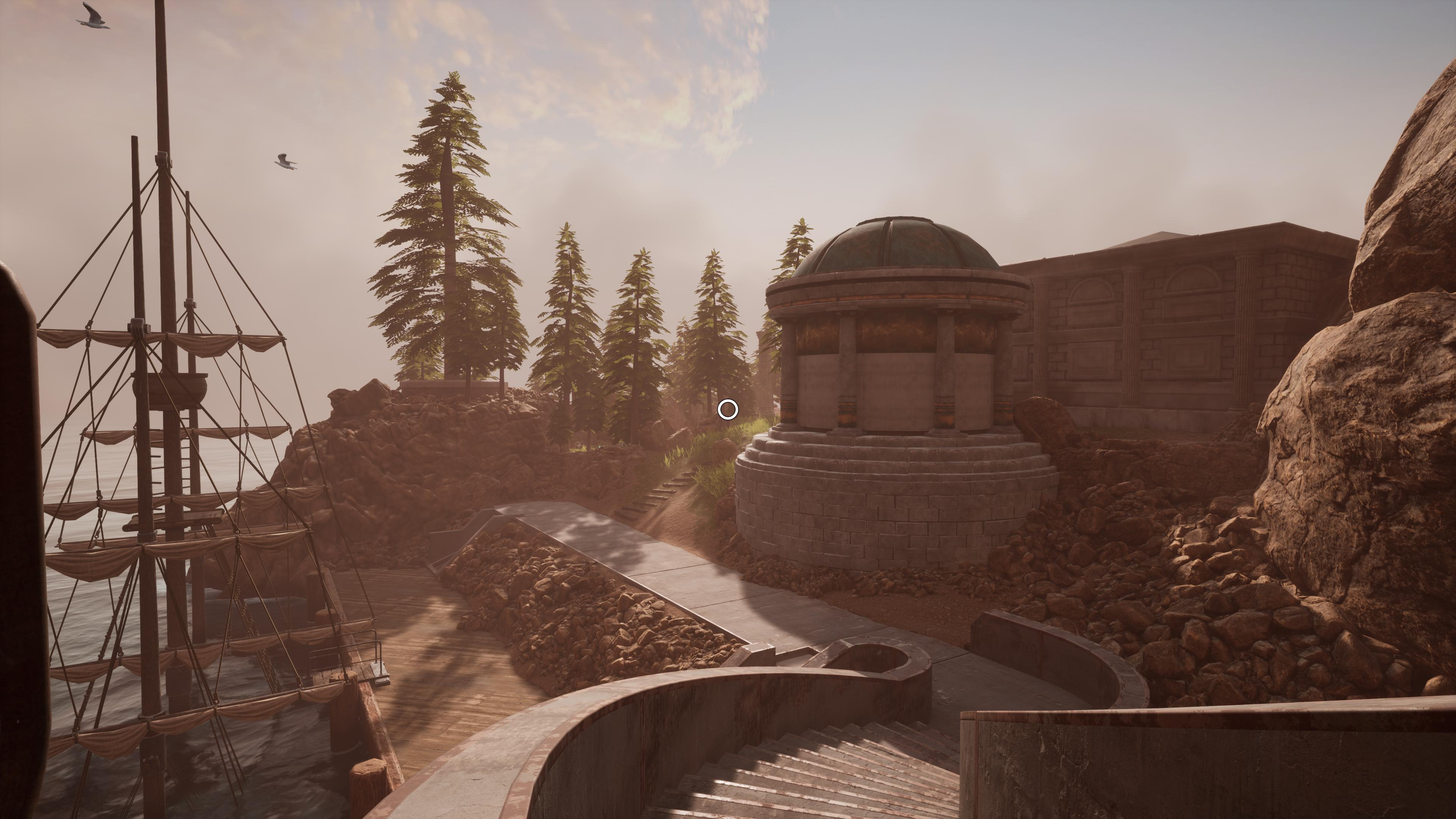
Myst island contains a library. Inside are four books, which are journal entries written by Atrus about four unique Ages that you will explore throughout the game. These are well written, colorful and imaginative, and serve as good world building. They also contain various puzzle hints.
Also in the library are uniquely placed red and blue books that stand out, with red and blue pages next to them respectively. Inserting these pages into their respective books has an interesting result; they enable communication through the book with a man who seems to be trapped in another world. Each of the two books contains a different trapped man.
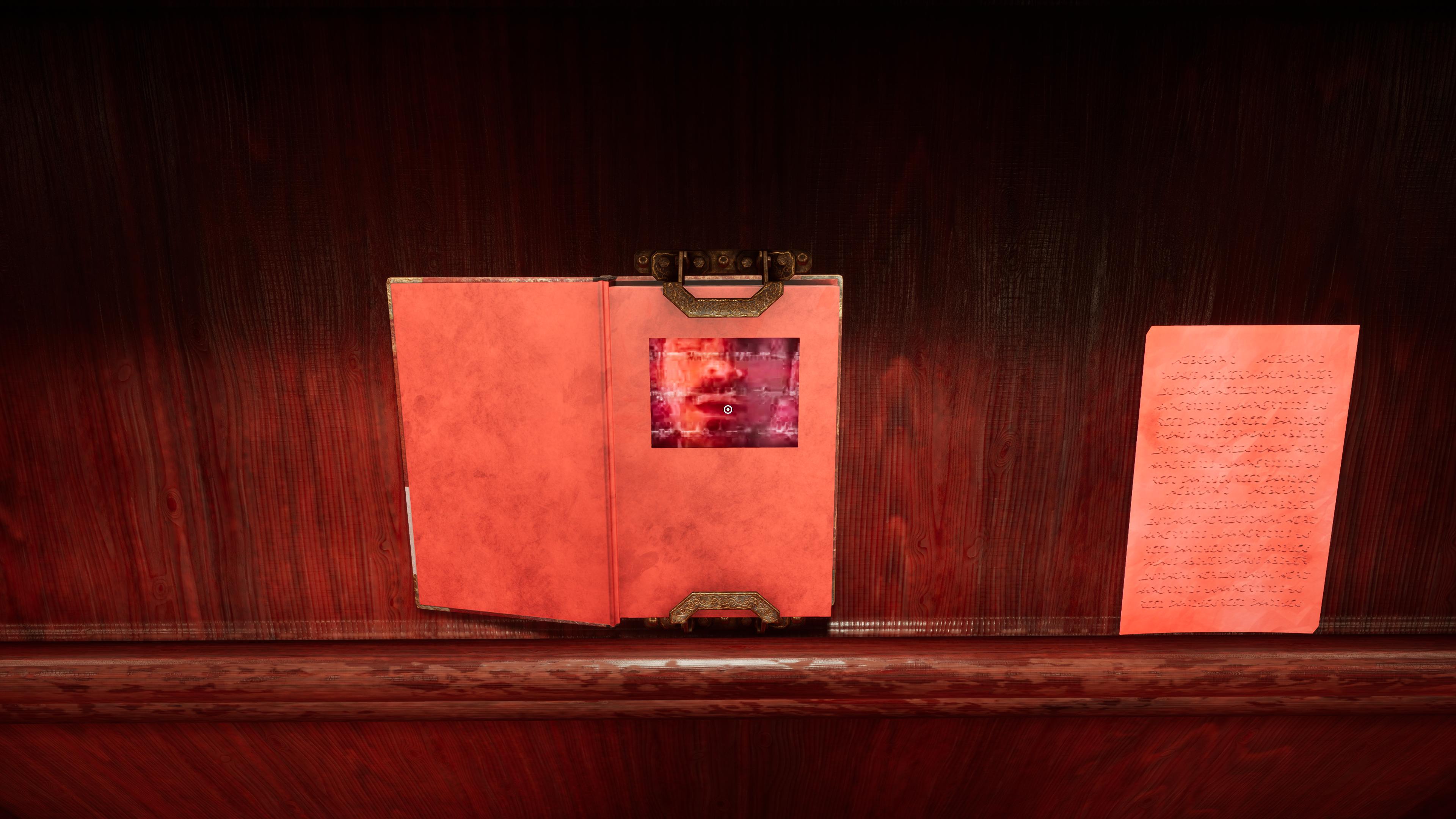
Note the screenshot above showcases a modification that restores the original FMVs with actual actors (the game’s creators). In this remake, these FMVs were replaced by in-engine, typical video game character models. However, our voices were heard, and now original FMVs is an official in-game option!
So Myst is about exploring, adventuring, and solving weird puzzles. Those with “Escape Room” experience should have a significant advantage for these puzzles. Communication with the men trapped in those books is unclear and filled with interference, but one thing is immediately clear – each of them is begging you to retrieve more pages that share the color of the book they’re in. These pages should help free them. But why are they trapped in the first place? You must find out for yourself.
Without having your hand held, it should be obvious that your goal is to solve puzzles on Myst island, unlock Ages, travel to these Ages, explore them, figure out what is going on, and find more of these red and/or blue pages in these Ages for these mysteriously trapped men.
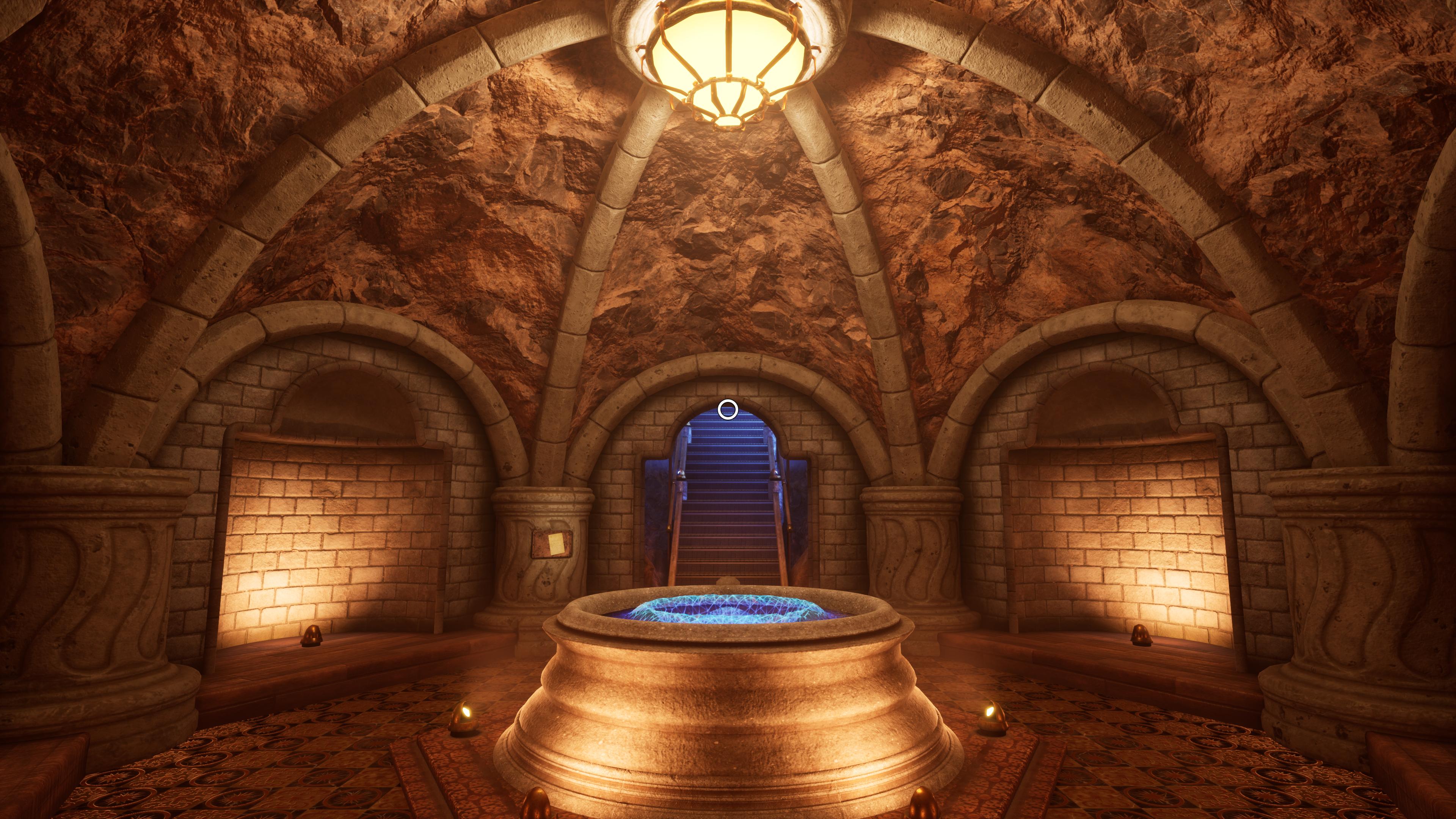
Each Age is one of a kind with its art design, clearly one of the primary strengths of Myst. And they each have the writing to back them up too, courtesy of the books in the library. I am a relative newcomer to this series, first playing realMyst: Masterpiece Edition, the 2014 Unity engine remake. That game had very outdated technical graphics in 2014, yet the art design overcame that easily. As a result, these Ages dropped my jaw when I first saw them. Every game by Cyan Worlds just has this effect on everyone, it seems. The art design is just so extraordinary. Their games remain some of the most visually potent games I have ever played.
Myst is visually unmistakable. Truly iconic. So is every game by Cyan Worlds, they are true masters of creating breathtaking worlds. But is there substance once you get over how pretty it is? Or do we have another No Man’s Sky on our hands?
Thankfully, there is adequate substance, hence why Myst spawned the franchise that it did. Myst stands out as being quiet; something is not right here, nor in any of the Ages. You meet nobody. Something bad happened, and it must have something to do with those imprisoned men. On each Age, you can find traces of these men, which leads to environmental storytelling that says much about them. The substance is there, and it is all amplified by VR, which we will discuss below.
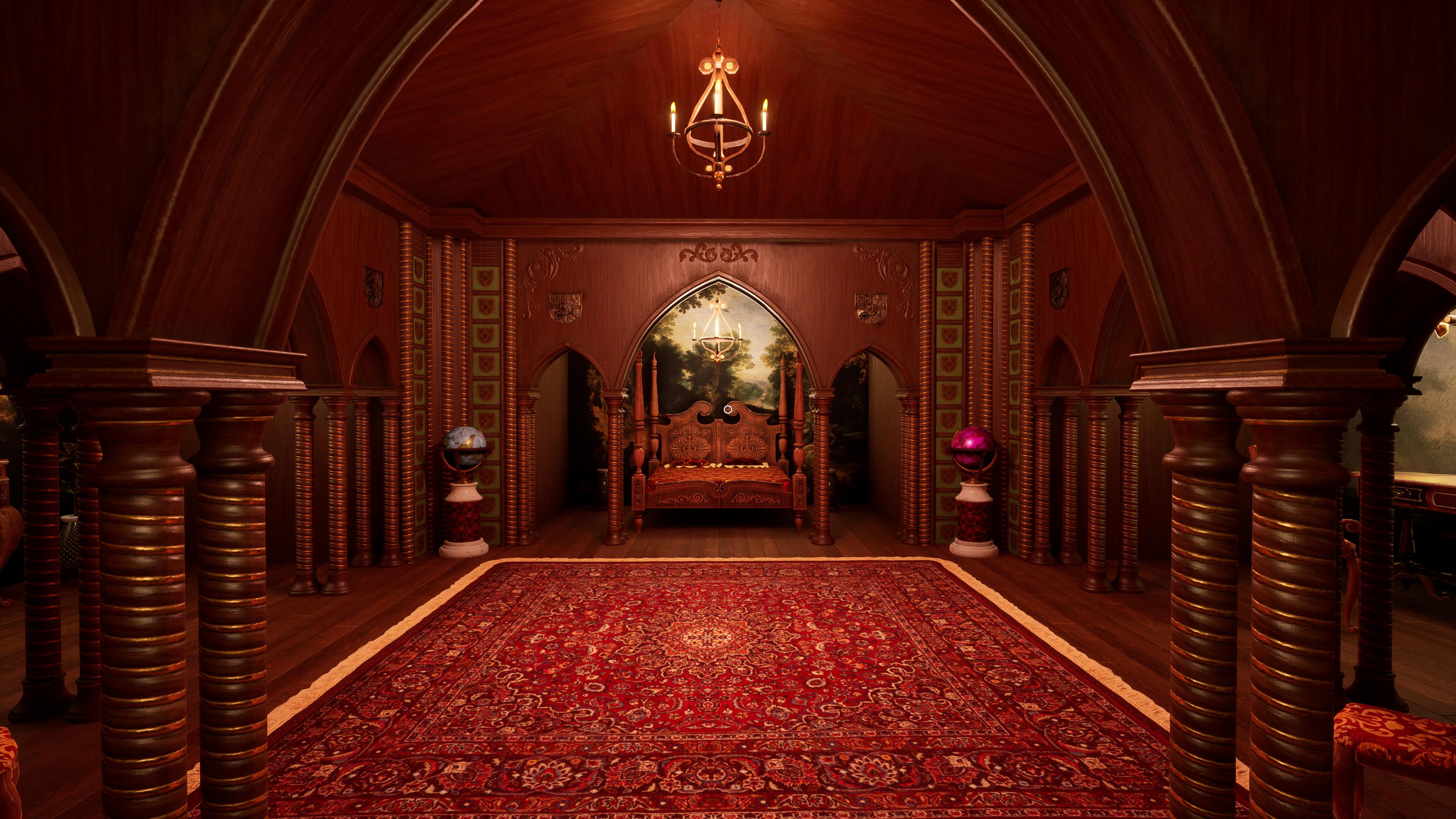
The Ages are not only artistically unique, but mechanically unique as well, which keeps them very interesting. No two puzzles are the same in Cyan’s games either, which is why they remain a standard to which all other puzzle games are compared.
The puzzles are abstract, but not deeply complex. Most are solved on the spot, and they’re actually fairly straightforward once you understand what needs to be done. Many follow simple mechanical or physical logic. At least two puzzles can even be brute forced, but obtaining the solution is inevitable.
Puzzle gameplay involves simple object interactions. Outside of VR, that means mouse clicks, revolving your mouse to rotate a valve, clicking and dragging, that’s pretty much it. On that note, weirdly enough there are two valves in this game – one on Myst island which works by revolving your mouse like we see in many other games, and one on Stoneship Age which you just click to interact with. Strange inconsistency but not a big deal. Myst is so mechanically simple that you can’t even rebind keys, and it’s not even a grave offense for a game this mechanically simple.
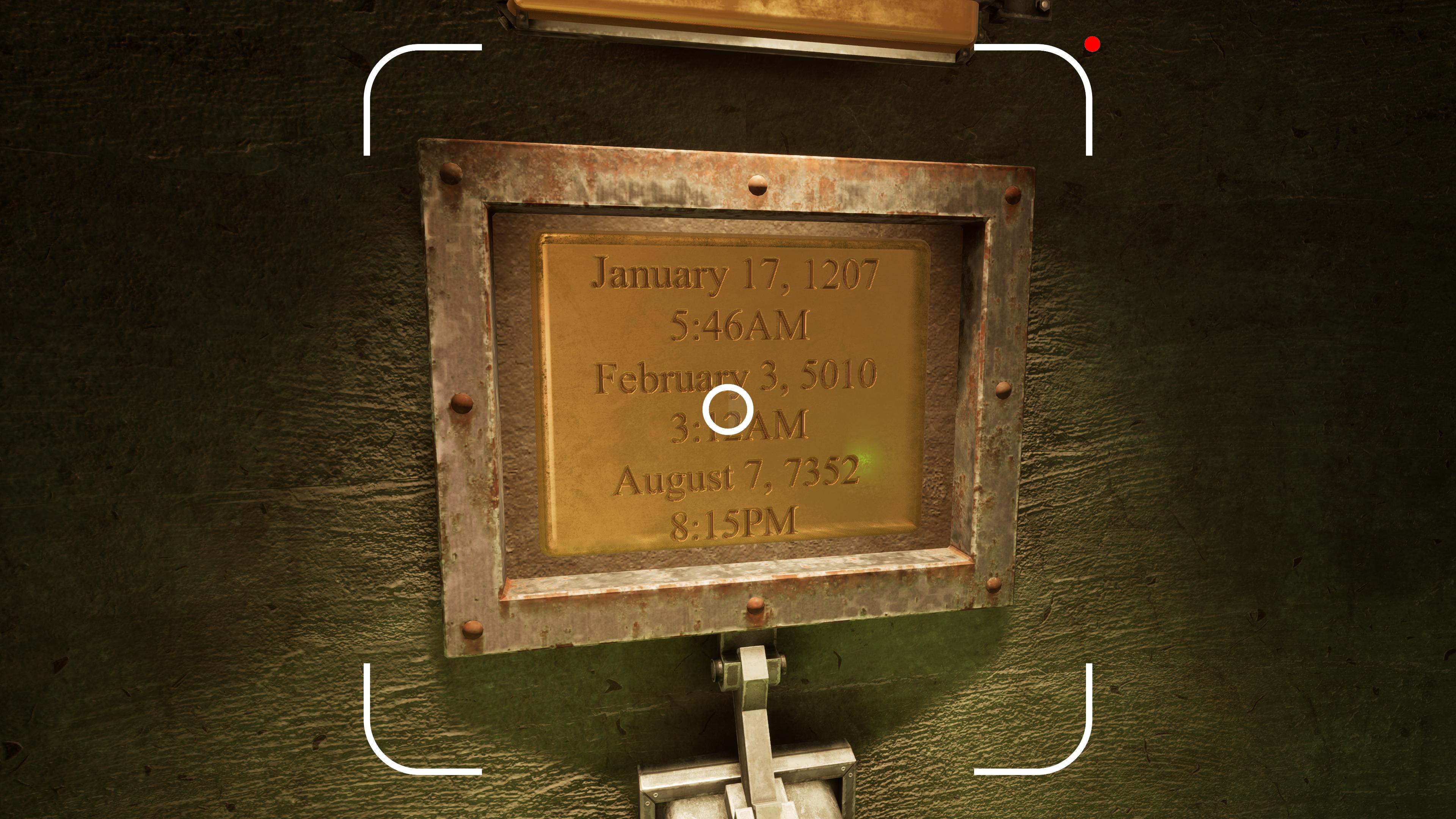
New to this version is a camera. Press spacebar (or a VR controller button) to line it up for a shot, and press it again to take the shot. Photos are viewable in-game. As the screenshot above demonstrates, this is to avoid having to write things down, which every Myst player had to do in the past. Note that the in-game photo album lists all photos, and doesn’t separate them by save game slot.
There is one puzzle in Myst that many players dread (as is often the case with puzzle games, Cyan’s in particular), and that is the maze in the Selenitic Age. A dark, underground maze which you must navigate from a train-like vehicle. It will take first-timers some time to figure out the clue that helps you navigate, however trial and error is not too bad as long as you map your progress, which is what I did when I first played the game. Though you cannot map your progress in VR without removing/raising your headset and writing it down.

When I first played Myst, I used online aid once, in the Stoneship Age. As far as puzzle games go, it is probably in the middle of the road when it comes to difficulty. Some might claim it is beyond that, but I disagree. There isn’t that much depth or complexity to these puzzles, and most are quite straightforward. The hardest part is getting started, but once you do that, the rest should fall into place.
But the puzzles aren’t too easy, and they are well designed due to how unique each one is, and because they aren’t all used for solving illogical problems. A few are guilty of this though, namely raising the bridge to the clocktower on Myst island – why can’t we just walk through that shallow water? This sort of thing can ruin suspension of disbelief if it is too prevalent, but thankfully this is rare in Cyan games. Rare but always present nonetheless. These logical deficiencies are defining elements of the Resident Evil franchise and many other console games however, so even today many gamers accept it.
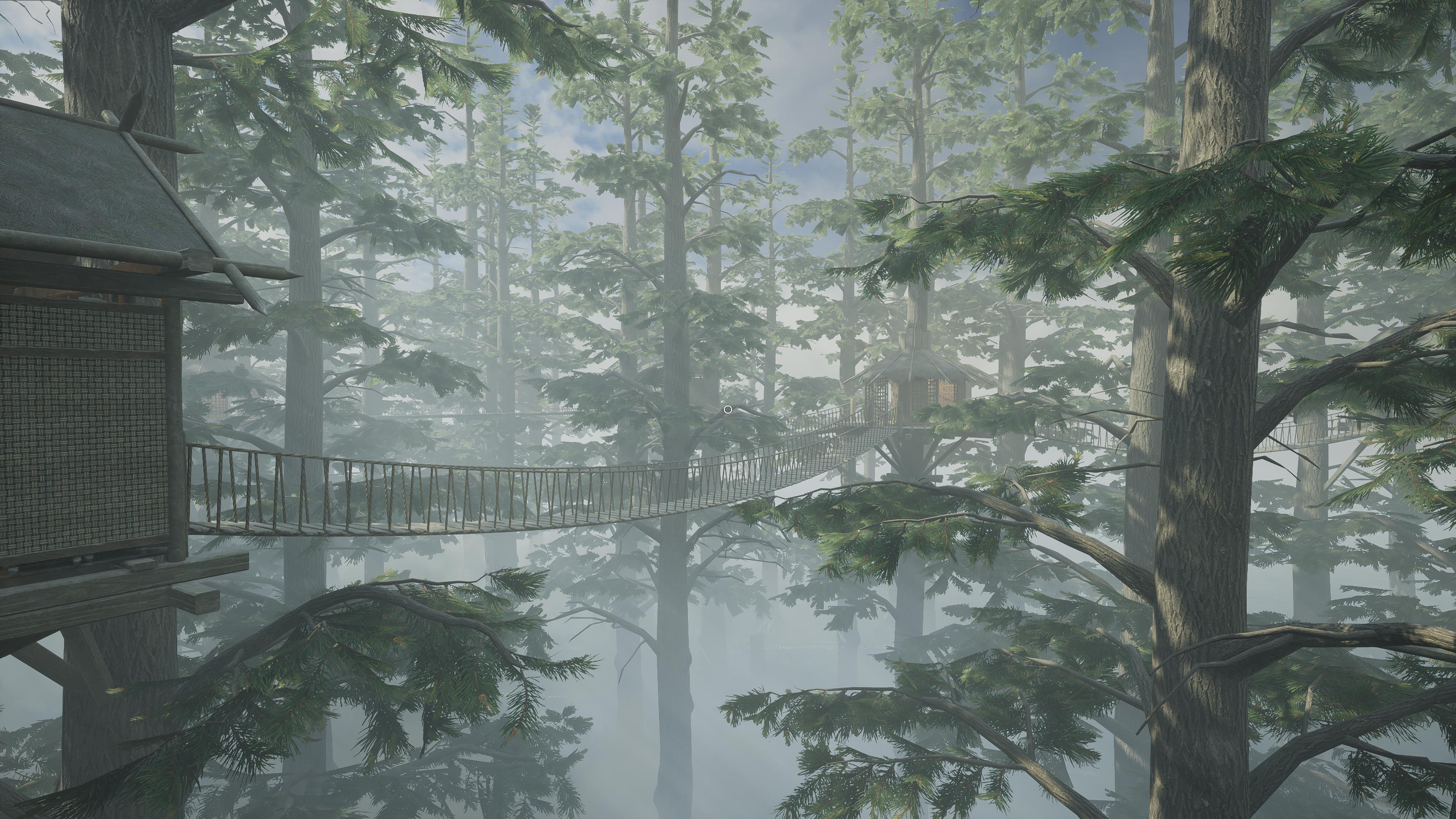
Myst excels as an adventure game, a puzzle game, and at creating an enthralling introduction to a unique world that makes you want to learn more. This isn’t nostalgia speaking; as I mentioned earlier, I first played the 2014 remake of this game (and I played it in 2016 for what it’s worth). I was surprised at how a 1993 game still lives up to its reputation. Indeed, I do not feel the same way about DOOM – an undeniable pioneer no doubt, invaluable to the development of gaming, but in my opinion dated design. But I digress.
Myst does not demonstrate the enormous worlds you get from today’s games that feature such innovative eye candy like Obduction, Subnautica, or No Man’s Sky. Myst is concise, quiet, but not in any harmful ways or overly artificial ways. You’re not exploring entire planets, you’re traveling to specific locations in these Ages and it makes sense. It’s also nice to not have every game be a time consuming gargantuan.
Is This the Definitive Version of Myst?
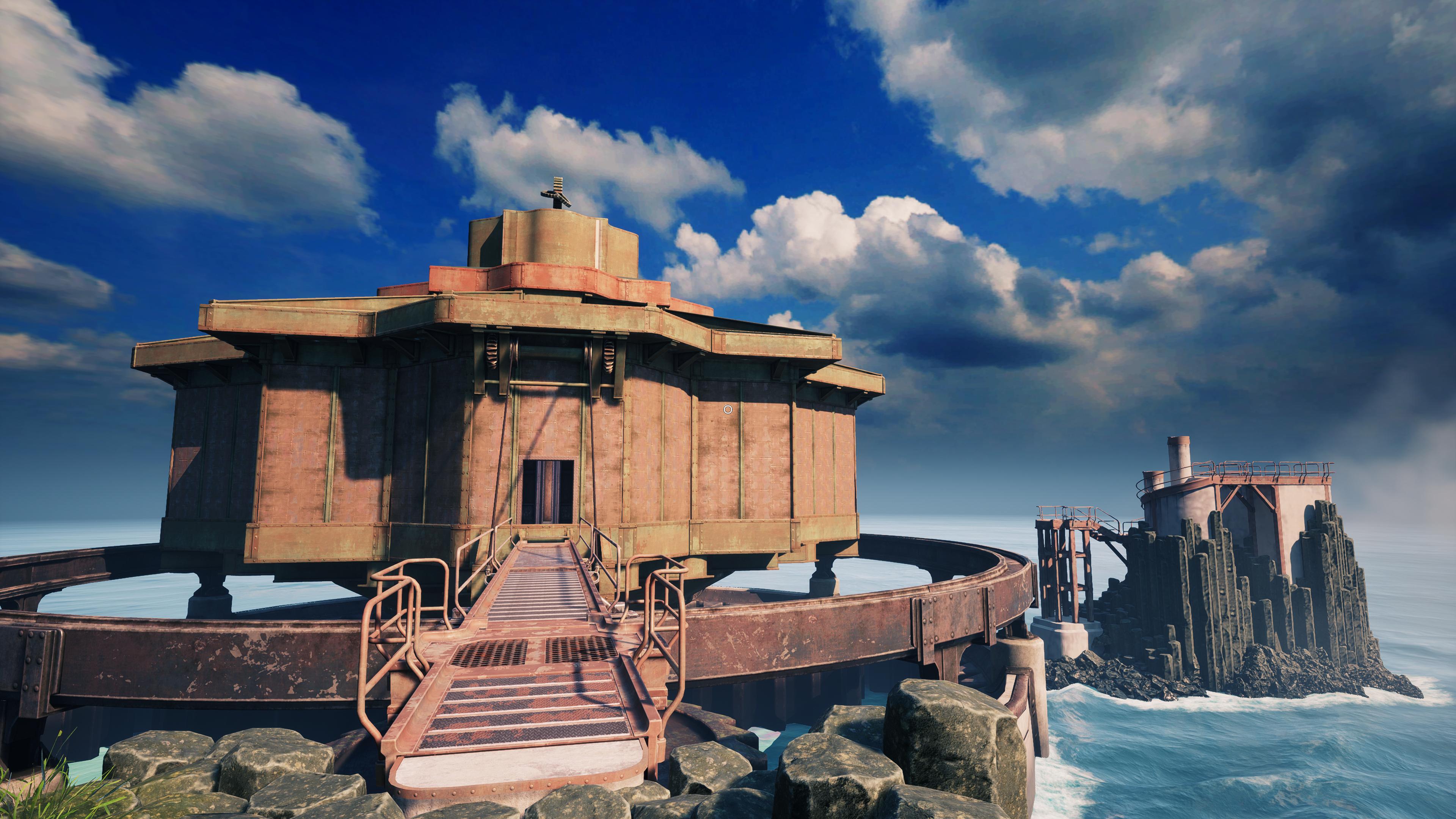
Yes, but there is one caveat: it’s missing the bonus Age, Rime, added by realMyst, the first 3D remake of Myst. realMyst: Masterpiece Edition also has Rime Age. Rime was actually the Age I was most looking forward to seeing in VR, and it’s not here. You can’t fault this game too hard for this though, since it wasn’t in the original game, and there are rumors that it is a planned inclusion in the future.

No Rime Age in exchange for by far the best looking version of Myst, best performing 3D version of Myst, and most of all virtual reality. It is an easy choice, and not even one that is generally disputed by the Myst community. Especially since it seems to be expected that Rime Age will be added eventually, but don’t base your purchase on that hope. This remake is also missing dynamic weather and dynamic day/night cycle, curiously enough.
This version omits pre-rendered environments from the original game, as well as the teleport movement like in the realMyst versions. Amusingly enough, VR can get closer to the original teleport movement, but of course that’s just VR’s normal free roam teleporting for comfortability.
There is one minor disappointment with this game, but it is a shortcoming all Myst versions share if I’m not mistaken – when looking down at Myst island from the tower through the window, you’re looking at a 2D image. I was hoping this Unreal Engine 4 remake would finally bypass this shortcoming… it would be really nice if it did, especially for VR players.
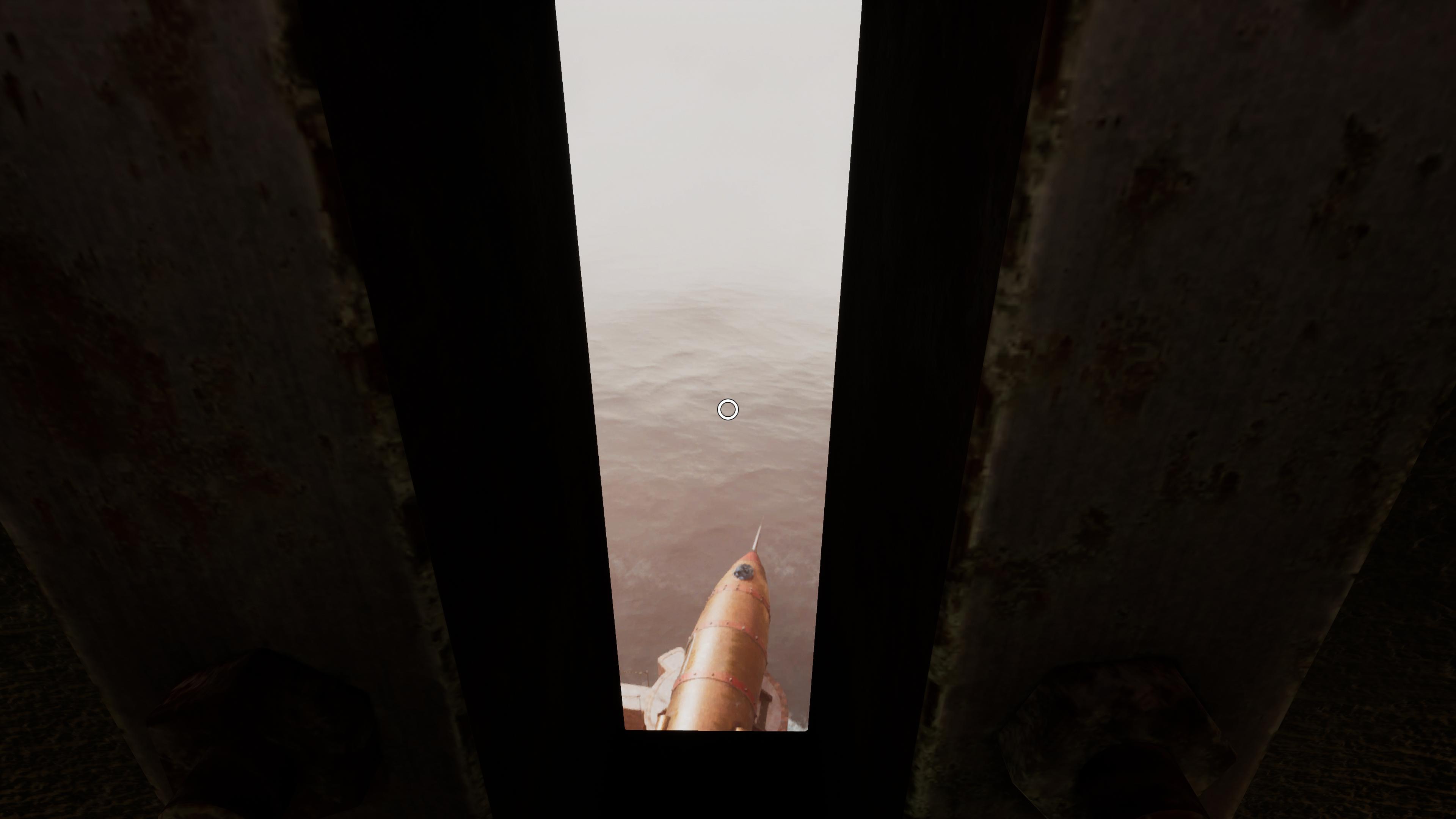
One nice gameplay touch for this version is that you can now collect both the red and blue pages on every Age. In past versions you could only hold one, so you’d have to backtrack if you wanted to get the other.
One technological note that has always been true about Myst is the importance of sound. Sound is important in many of the Ages for solving some of the puzzles. Thankfully, this remake’s sound is up to the task, having particularly good spatial accuracy with my 5 channel surround setup. So good that I wondered if this was using Steam Audio like the upcoming Riven remake is using, but it is in fact XAudio 2.9.
The visuals, as you can see from all the screenshots in this review, are outstanding. Not the strongest technological powerhouses that DOOM Eternal and Metro Exodus: Enhanced Edition are, but you get Unreal Engine 4’s top notch shaders, post processing, TAA (top notch outside of VR at least, in VR is a different story but more on that later), and near photorealistic PBR (especially in VR). This game also includes both AMD’s FSR and NVIDIA’s DLSS 2. Ray tracing in this game is a waste of time and resources however – it only affects reflections, and makes them look worse at least in one area, highlighted below. The top screenshot has no ray tracing, the one below does.
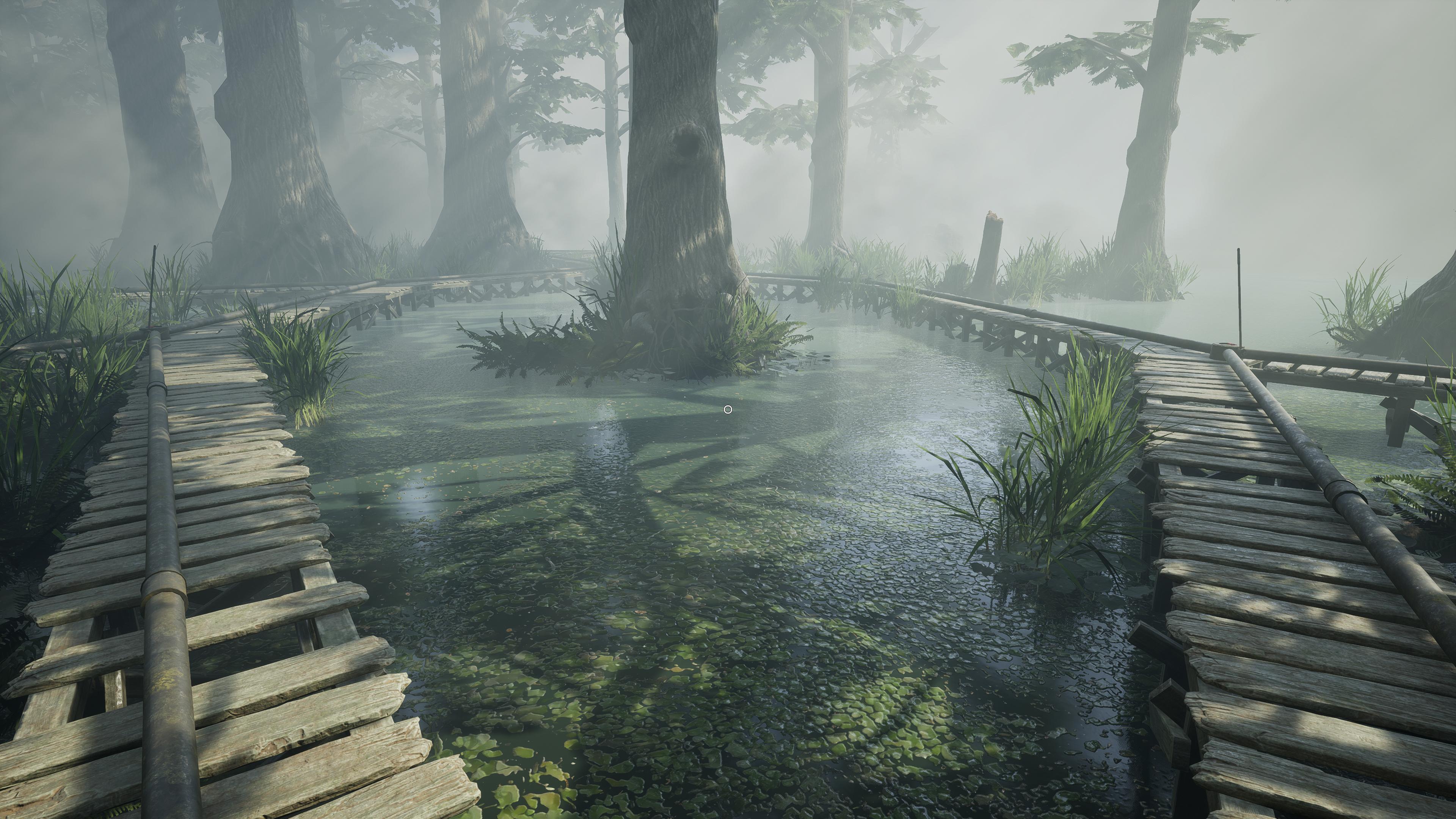

Notice how the reflections around objects create a weird, distorted highlight of sorts. Amusingly enough, I have only seen two visual differences with ray tracing – the broken reflections above, and this one reflection shown below. No ray tracing in the top screenshot, ray tracing enabled in the bottom.
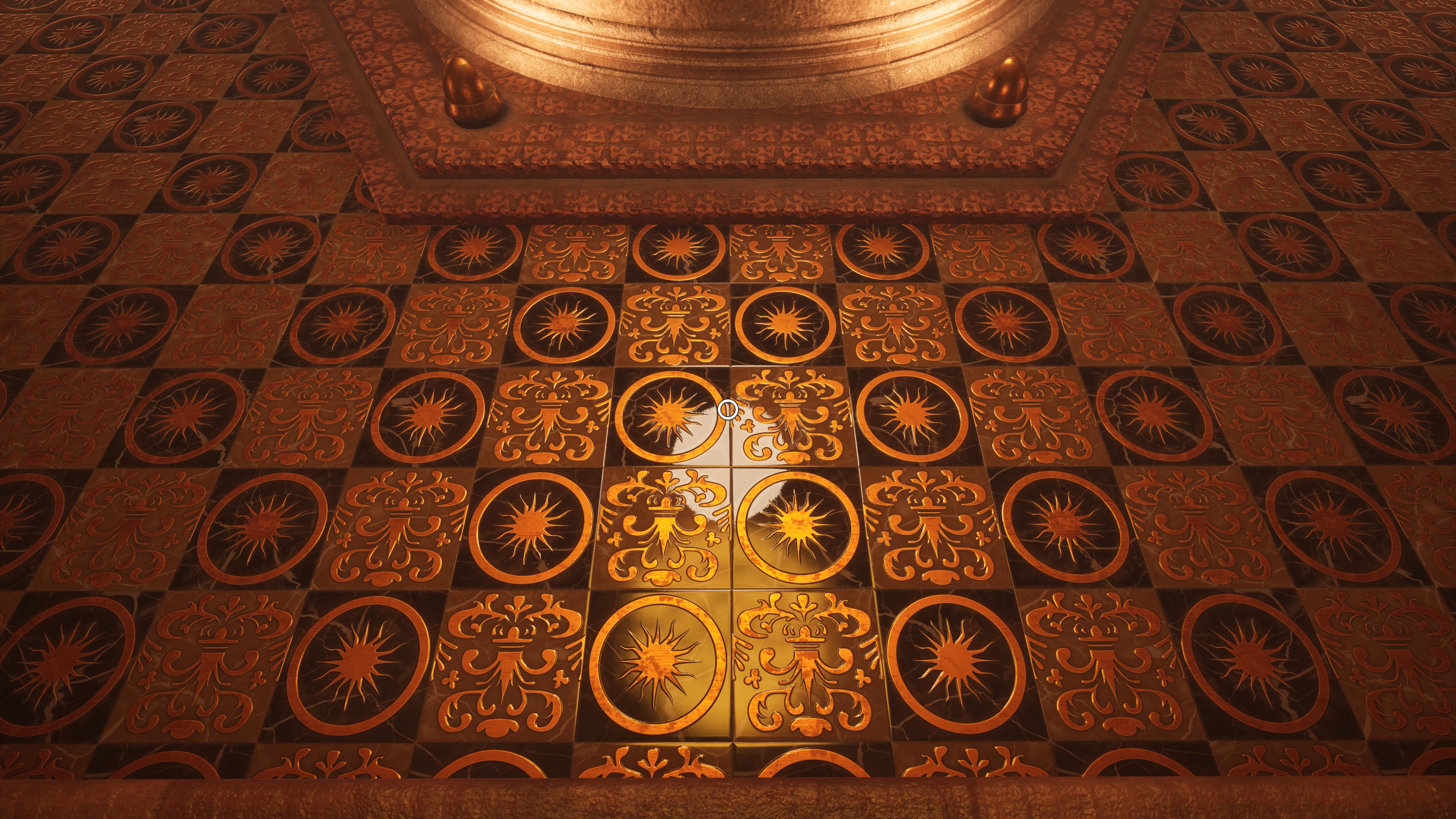
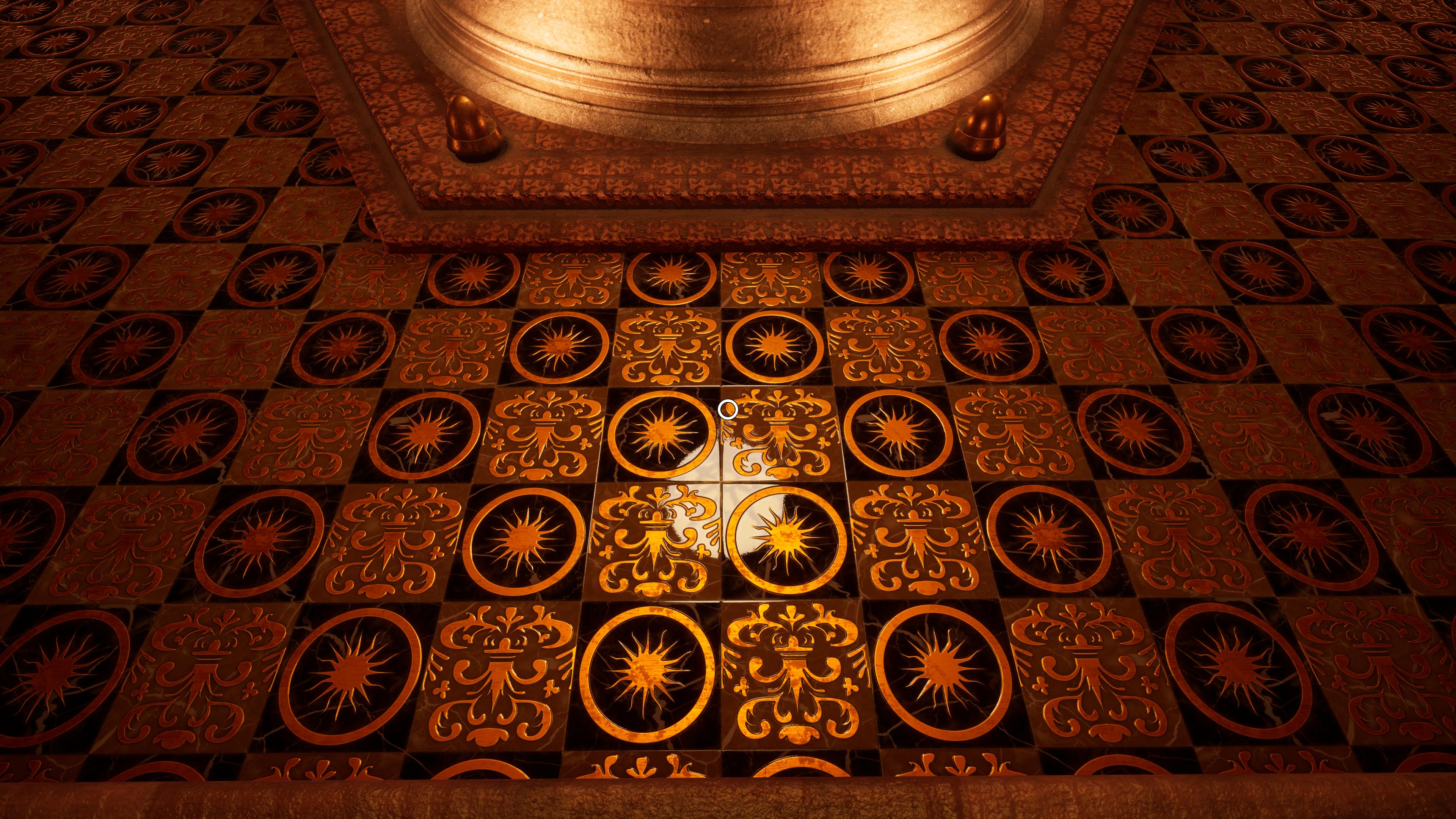
That’s it. Don’t waste your time or frame rate with ray tracing in this game. And no, this isn’t a statement against ray tracing – it is revolutionary technology as explained here. This is just a bad implementation.
While we’re on this subject, let’s look at FSR visual comparisons. The top screenshot for each comparison below uses no FSR, while the one below it uses FSR Ultra Quality.
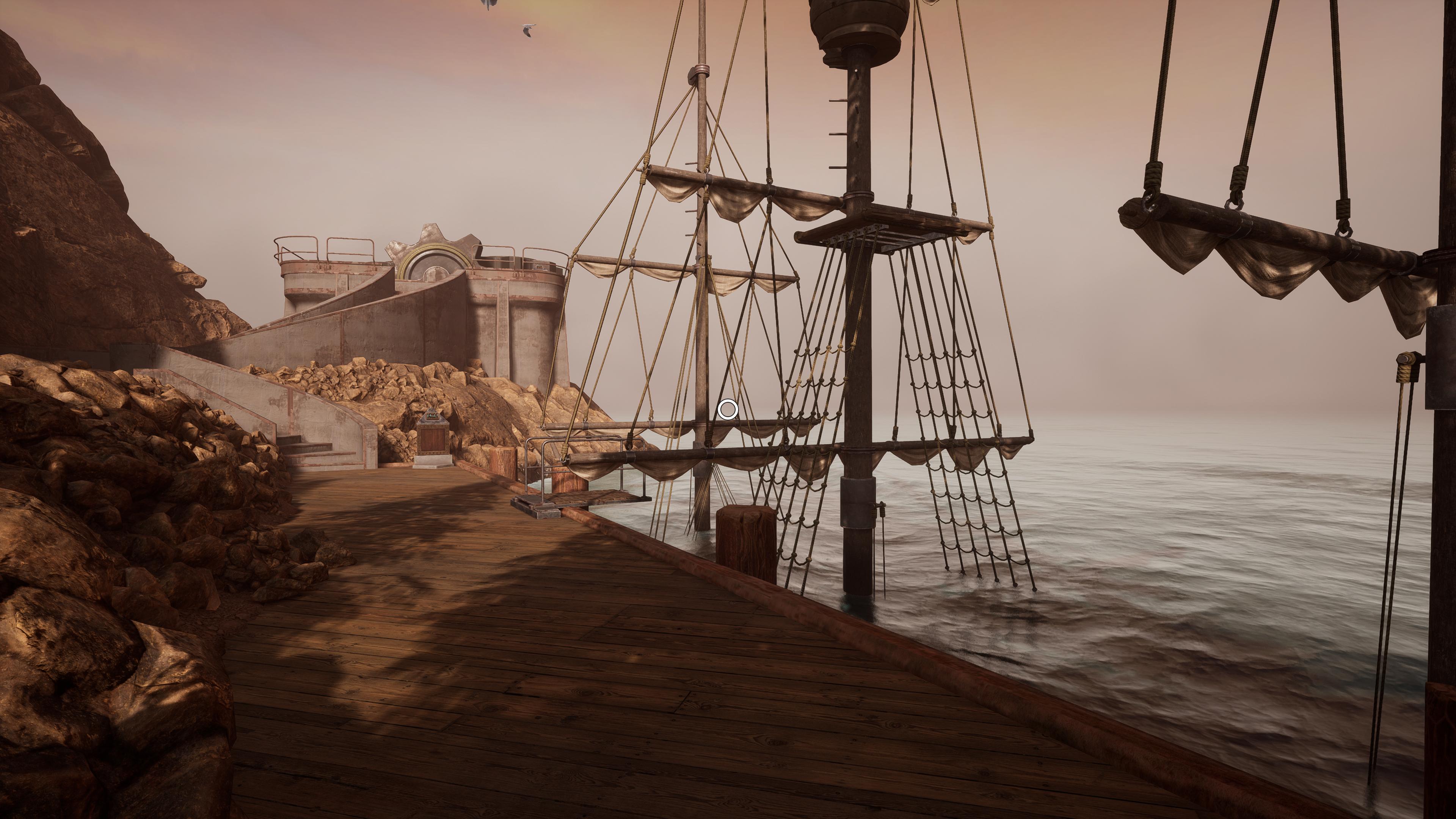
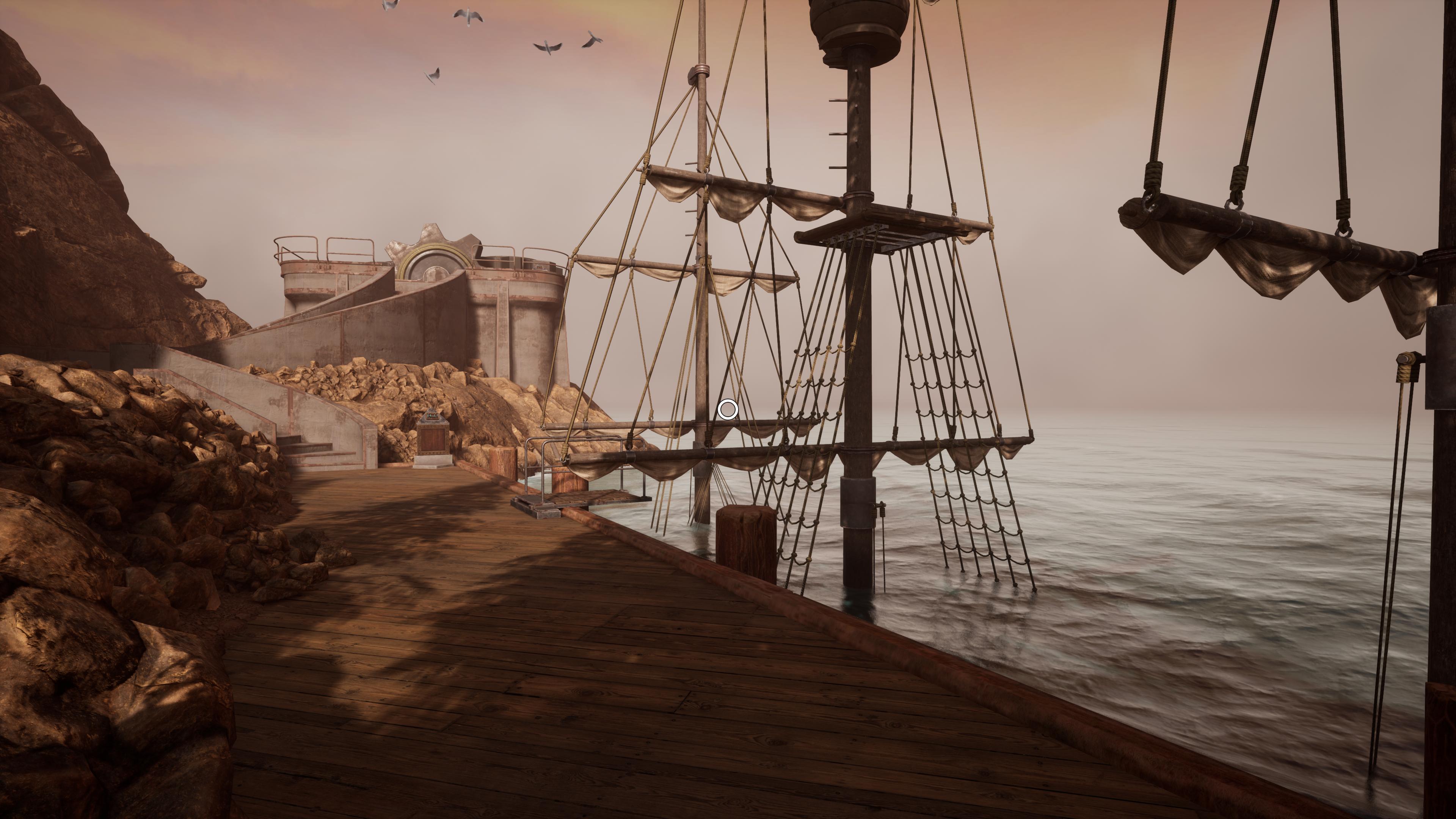
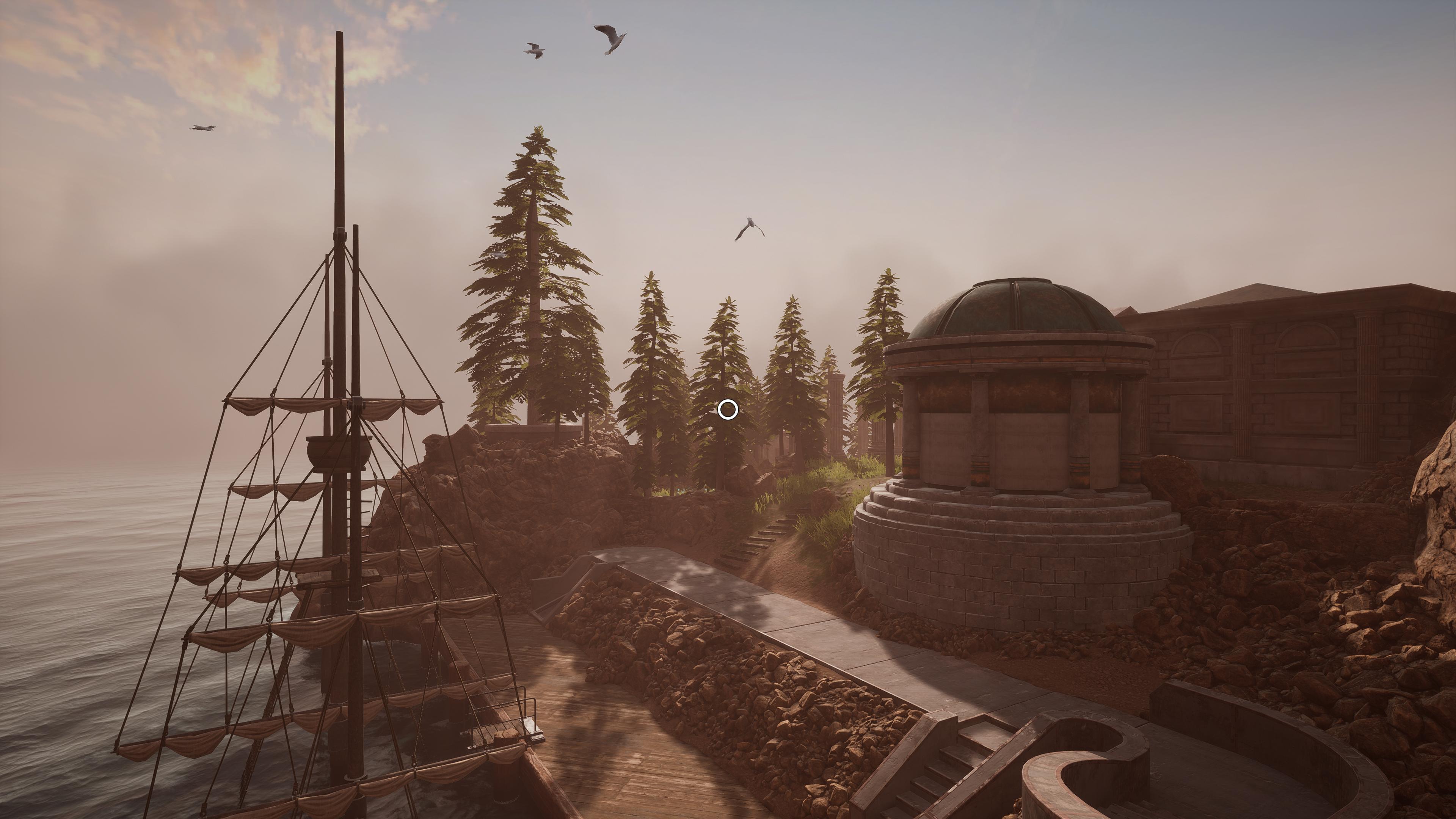

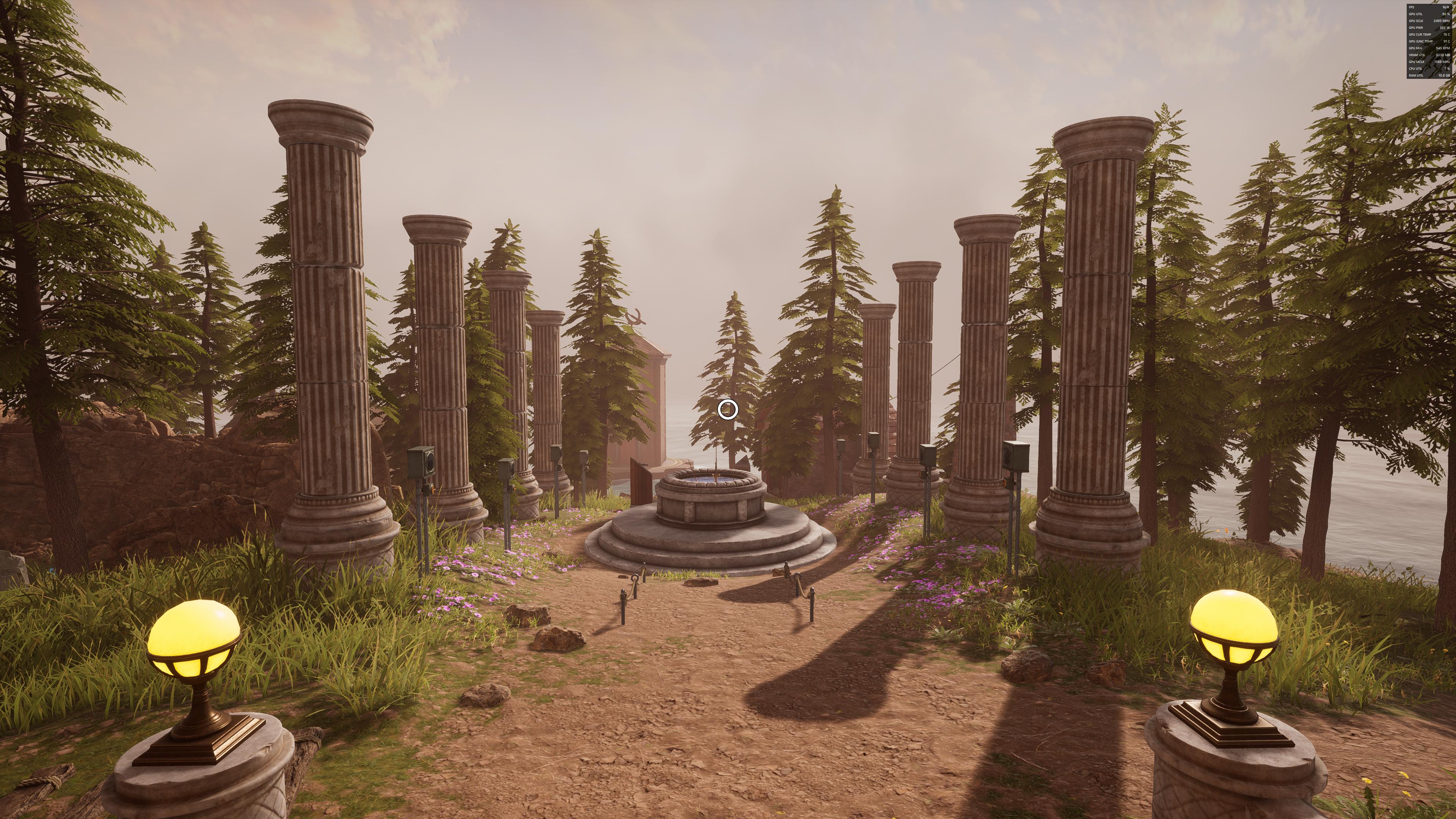
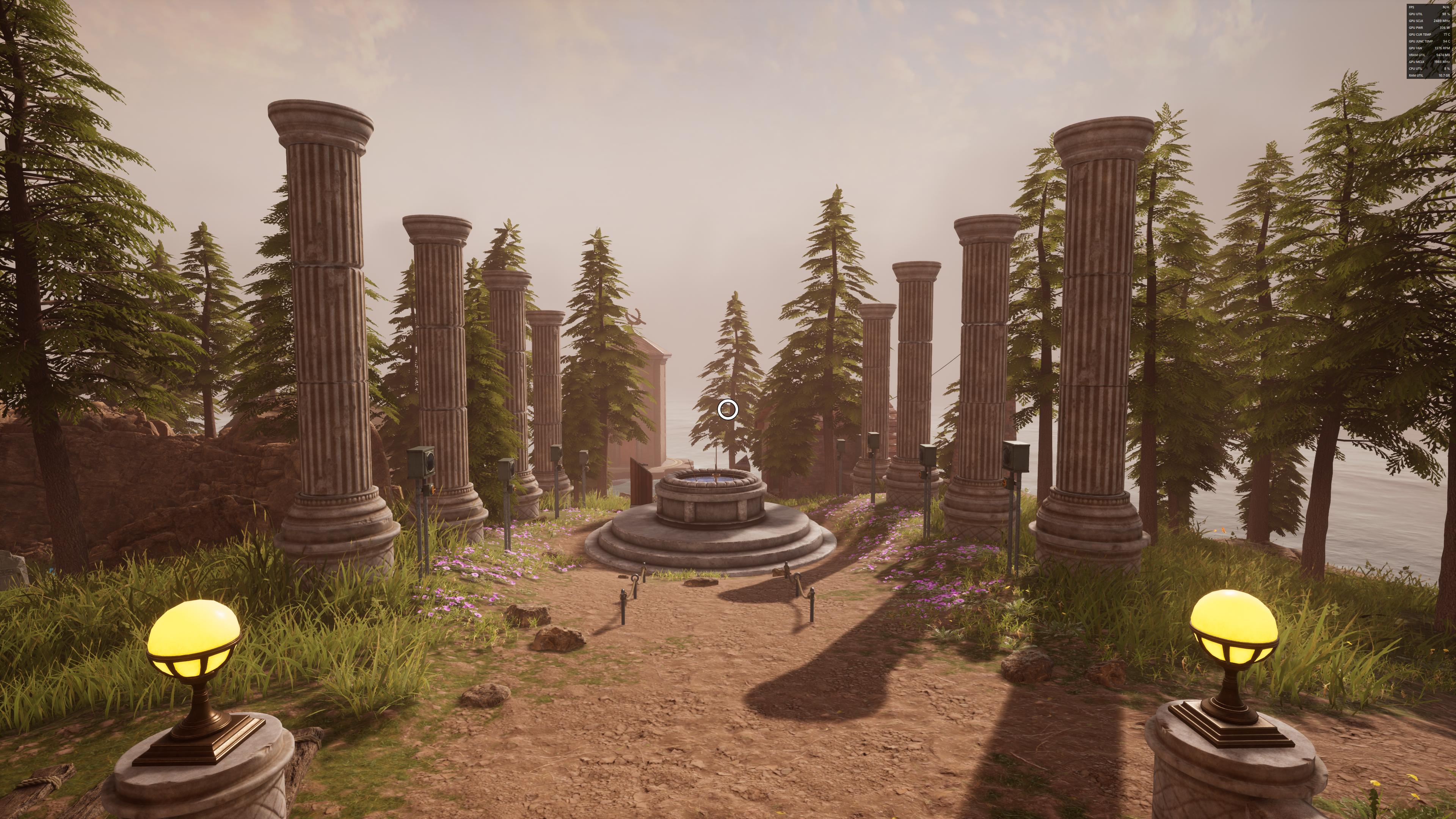
In these screenshots, you can see slight blurring in the distance with FSR Ultra Quality. You can also see a slight difference on the ropes hit by sunlight in the first comparison photos. In practice, none of this is noticeable. It is practically free performance.
Speaking of performance, this remake uses Unreal Engine 4.26.2. Considering this, the performance is what you’d expect for a small scale, not heavily customized Unreal Engine 4 title – that is to say, it’s easy to run. Not state of the art optimization but not a tall task for modern hardware outside of VR.
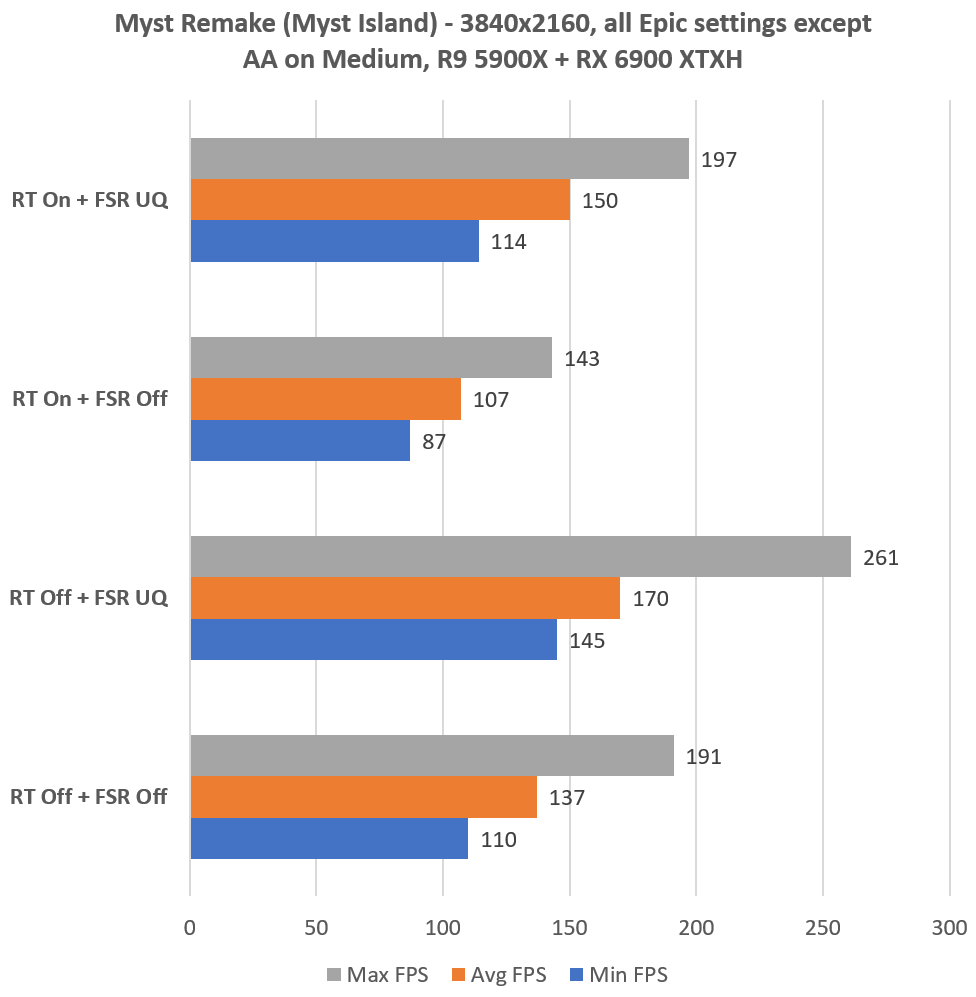
realMyst: Masterpiece Edition, the 2014 Unity engine remake, doesn’t come anywhere near this level of performance. Older games just can’t use hardware as well as today’s games, especially DX12 Ultimate games like this one.
The other advantage to this version of Myst, besides making all the others look like decayed relics in comparison and besides the higher frame rates, is the random puzzle option. This means nothing to newcomers to the game, but to Myst veterans, you will have to find puzzle solutions again. The random puzzle option doesn’t extend to puzzles that have inherent level design elements, it makes the following changes:
- Myst Island – Most of these are randomized. Marker Switch puzzle is now randomized, but always seems to involve The pattern of the fireplace puzzle is randomized now, but the page that illustrates the solution of course isn’t because it is spoken by characters. The solution to the ship puzzle is randomized, which means so are the dates and times you must enter in the Planetarium. The time you must enter on the clock is randomized, as are the voltage you must enter in the generator room, the musical notes in the ship, and the three digit safe code. Oddly enough the 3 digit code you must enter inside the clocktower was the same three times for me, but others have reported randomization.
- Mechanical Age – The pattern you must enter to lower the steps to the Myst linking book is randomized.
- Stoneship Age – The telescope’s scale is always randomized.
- Selenitic Age – The sounds and symbols are always the same because they describe something that is constant and objective in the level design, but the order for the door puzzle is randomized. The maze is randomized, although when I tried it on this mode I had the original solution.
Before we move on, here is a technical breakdown of the game.
| 64-bit | Yes |
|---|---|
| Linux Support | No |
| Graphics API | DirectX 11 (recommended) DirectX 12 (not recommended) |
| Frame Rate | Unlocked |
| High Resolution Support | Yes |
| Ultrawide Support | Yes |
| High Refresh Rate Support | Yes |
| Borderless Windowed Support | Yes |
| VR | Yes (doesn’t work on Varjo) |
| Display HDR | Config File Edit |
| Shader Compilation Stutter | No |
| Ray Tracing | Buggy Reflections (looks better without) |
| Mesh Shader Virtual Geometry Pipeline | No |
| NVIDIA Micro-Meshes | No |
| Advanced Distance-Based Level Streaming System with No Loading Screens | Yes |
| Variable Rate Shading | No |
| Sampler Feedback Tiled Texture Streaming | No |
| Sampler Feedback Texture-Space Shading | No |
| DirectStorage/RTXIO | No |
| Multicore CPU Support | 4-8 cores |
| GPU Physics | No |
| Adjustable FOV | Yes |
| Anisotropic Filtering | 16x |
| Anti-Aliasing and Upscaling | TAA |
| Sound API | XAudio 2.9 |
| Sound | Up to 7 channels |
| Dolby Atmos | No |
| UI Scaling | Yes |
| “Analog” Keyboard Support | No |
| Debug Console | No |
| Modding | No |
The VR Experience
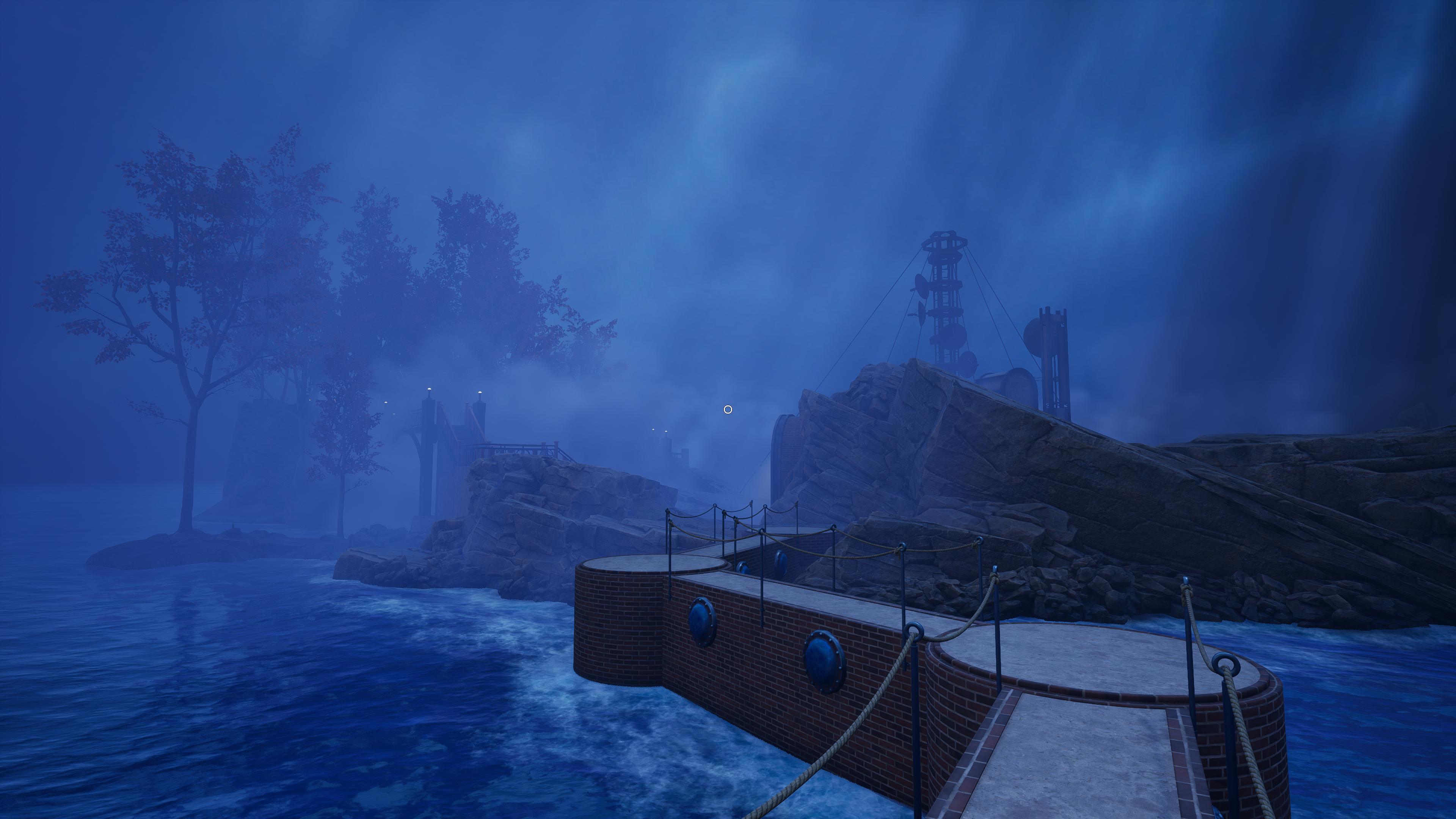
VR is a launch option for Myst (-vr), so if you’re having trouble launching it in VR with the GOG version, that’s why. For some reason, the non-VR game initiates SteamVR so this may throw you off.
This game was actually a temporary Oculus exclusive since late 2020, who basically beta tested the game for everyone else. Now it supports SteamVR. I played it on my new HTC Vive Pro 2 at its full 4896 x 2448 resolution. NVIDIA tested this resolution with this game and an RTX 3080, reporting an average of 59 FPS on max settings without DLSS. That aligns with my experience of getting 60-70 FPS with an RX 6900 XT, but keep in mind that 59 FPS is uncomfortable in VR.
For some reason, this game falls back to DX11 in VR. I’ve seen this from other Unreal Engine 4 VR games and also from Half-Life: Alyx, which is DX11 while Dota 2 uses the same engine and is Vulkan. This puzzles me. If someone can explain the reason for this in the comments, I’d be grateful for it.
Another oddity is that FSR cannot be used in VR, but DLSS can. Thankfully, FSR can be forced into this game using this, and the result is worth it since this game is a hefty task for even the RX 6900 XT and RTX 3090 at 4896 x 2448 VR and similar resolutions. Without FSR, even with medium graphics settings except high post processing, low shadows, and low anti-aliasing, I only get 60-70 FPS or sometimes 70-80. Lowering graphics settings doesn’t boost my performance much. But with FSR Ultra Quality, I can run everything on Epic and maintain 90 FPS (capped), similar to NVIDIA’s results except on my AMD graphics card. Every now and then in dense foliage, there will be a momentary frame rate drop, but it’s nothing really.
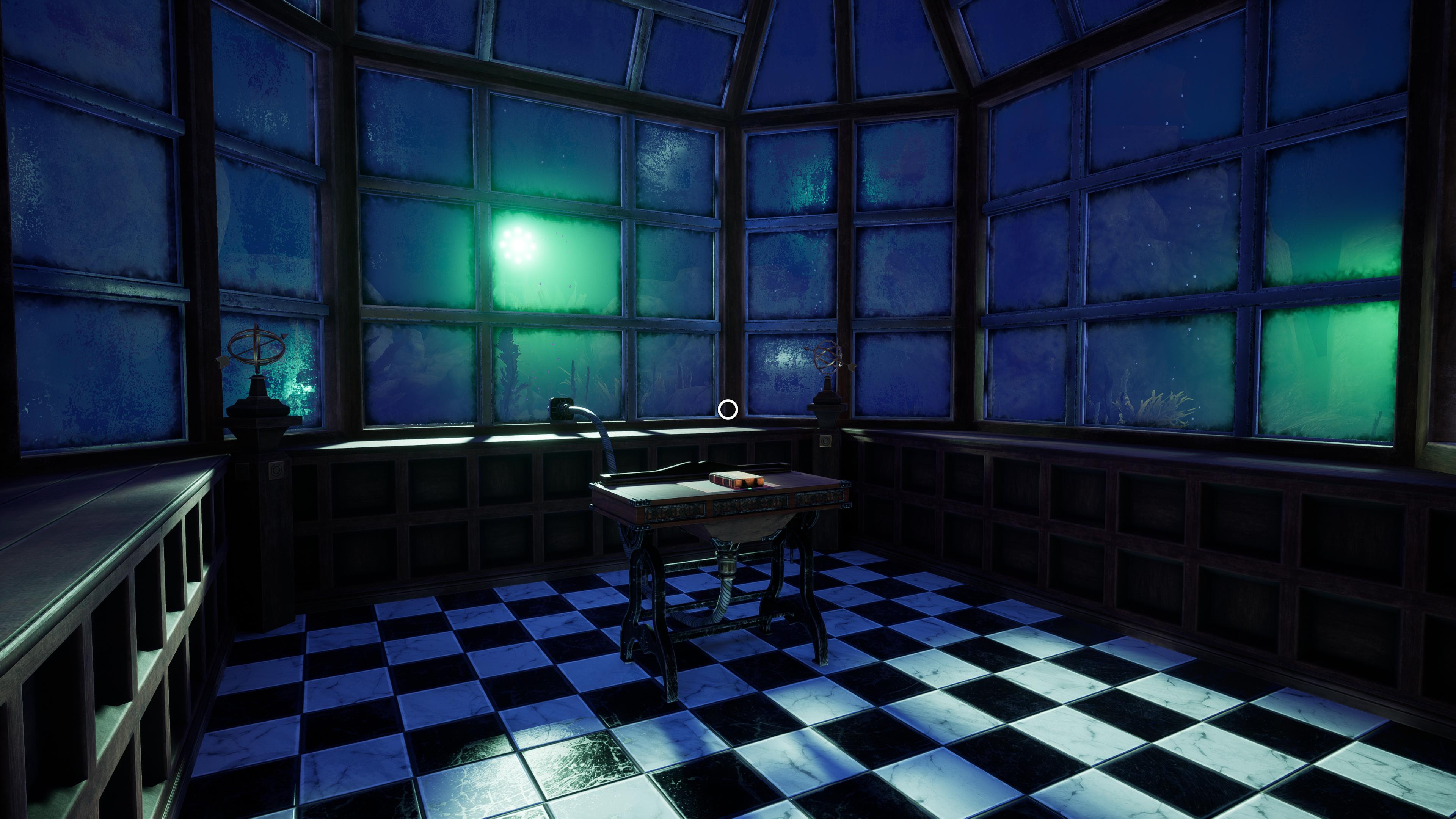
The tradeoff for FSR in VR is slight blurring. I can’t accurately do A/B comparisons since I use an FSR hack that requires restarting the game, and I can’t use DLSS. However, I did use DLSS 2 in another Unreal Engine 4 VR game: Into the Radius VR. In that, I noticed that with DLSS set to Quality, there was a slight blur on everything about 10 meters away from me and beyond. This is similar to what I see with hacked FSR in this game, and probably what you’ll see with this game’s DLSS.
The bottom line: FSR Ultra Quality and DLSS 2 Quality are basically free performance outside of VR (barring artifact issues with DLSS, which I’ve seen reported in this game but cannot verify), but in VR they are not. They should both become antiquated in time for VR gaming though, since eye tracking with dynamic upscaling based around that should take over one day.
Also, note that I keep anti-aliasing on medium in VR. While it is significantly aliased like this, and while high and epic settings remove virtually all aliasing, running TAA at high or epic blurs the image significantly. This game lacks built-in sharpening… if only it included AMD FidelityFX CAS. I tried forcing it via ReShade and this wrapper, but ReShade wouldn’t work in the game. UE4 TAA blur is normally an overblown issue outside of VR, with the offending blur usually caused by chromatic aberration rather than the TAA, but in VR it is a real issue, as even FSR and DLSS on their best settings create noticeable blur (resolution decrease).
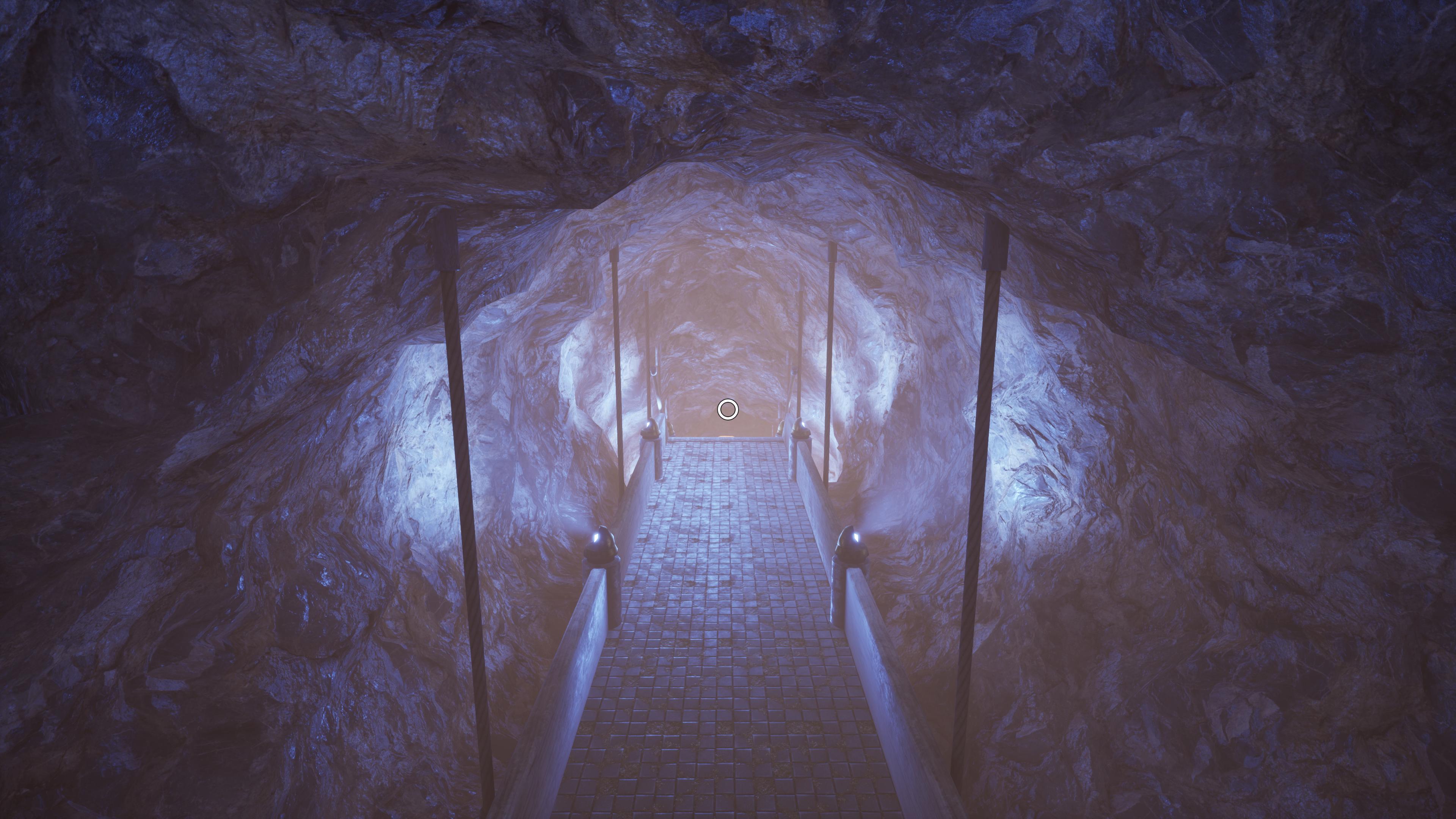
With performance out of the way, let me just say it: VR in this game is amazing, as expected. Obduction’s VR is imperfect because it was added after the fact, but VR is Cyan’s main focus now. I was able to try it in a demo for their upcoming Firmament, and Myst VR does not disappoint. Cyan games are such an obvious fit for VR; had the technology been around back then, they would have been the first to use it.
Opening a linking book in VR is something I’ve been awaiting for a few years, and others have been awaiting it for 28 years. Being a part of its incredible Ages is like a dream come true. You do not have a first person body mesh or detailed hands, since this game’s interaction is very simple. Even the interactive objects always move back to their original location to avoid accidents.
Some things work better in VR, namely looking at small screens like the telescope’s or the one in the Selenitic Age. Weirdly enough though, the control levers for the vehicle in the Selenitic maze can be used by just holding them in one direction outside of VR, but in VR you cannot do this and must constantly cycle them. Not a big deal though.

An interesting side effect in VR, the result of VR essentially amplifying all emotions and feelings, is felt in the Selenitic maze puzzle. You really feel trapped in there in VR, you really want to get out. This can be a problem for claustrophobic people.
Myst has the usual VR comfortability options: teleport or smooth movement, snap or smooth turn. It also has accessibility options for ladders and vehicles, so Myst would be a perfect game for introducing someone to VR gaming.
Some might ask, which Age is the most incredible to behold in VR? Ultimately, this just depends on what your favorite Age is. It’s so hard for me to choose, since they’re all equally incredible from a design standpoint. I suppose I was most taken back by the colors of the Selenitic age upon first entering.
Conclusion

All the great classics deserve remakes like this. Modern technology can make any game better, as long as the remake isn’t botched like some are. Thankfully, this one isn’t. This is the definitive version of Myst, but no version is perfect. This one really needs Rime Age to be added, it was the one I most wanted to experience in VR. I agree with the many players who wish that the FMVs stayed (and were AI upscaled/remastered). The character models are not good enough to replace the FMVs… I’d say no character models are, with the exception being in the true ending since that requires a character model in this day and age.
VR is the ultimate way to experience this game, for those who don’t suffer motion sickness from it. I can’t recommend it enough. It will help enable a newer generation to experience this wonderful, iconic game. Thankfully, VR is not a separate purchase, like it is for so many other games. That, and this game half the price of your typical game, and now available on many platforms including Steam and GOG.
Now I really can’t wait for the upcoming Riven VR remake, as well as Cyan’s upcoming Firmament.
Strengths
- VR and normal version included, and at a low cost
- Legendary, immortal, timeless art design, enhanced tremendously by Unreal Engine 4 and most of all VR
- Still some of the better environmental storytelling in gaming, and very nice world building
- Creative puzzle design that never repeats itself
- Random puzzle solutions are an excellent option, I hope Cyan keeps this feature in their future games
- Surprisingly excellent surround sound spatial accuracy, making this also the best sounding version of Myst
- That very memorable soundtrack
- Addition of a camera is very helpful
- Includes AMD FSR, NVIDIA DLSS 2, lots of VR comfortability options
- Fast loading times
Weaknesses
- Doesn’t include Rime Age
- Doesn’t launch on Varjo headsets
- No dynamic day/night cycle or dynamic weather from realMyst: Masterpiece Edition
- Had one issue in which the screen blacked out but the game was still interactive, required restarting the game
- Non-VR game cannot disable cursor
- Useless ray tracing implementation that ruins reflections on Channelwood Age, and usually does nothing for visuals
- When looking out the tower window on Myst island, you are unfortunately looking at a blatant 2D image
- One of the ladders on Selenitic Age has trouble detecting when you’ve finished descending it


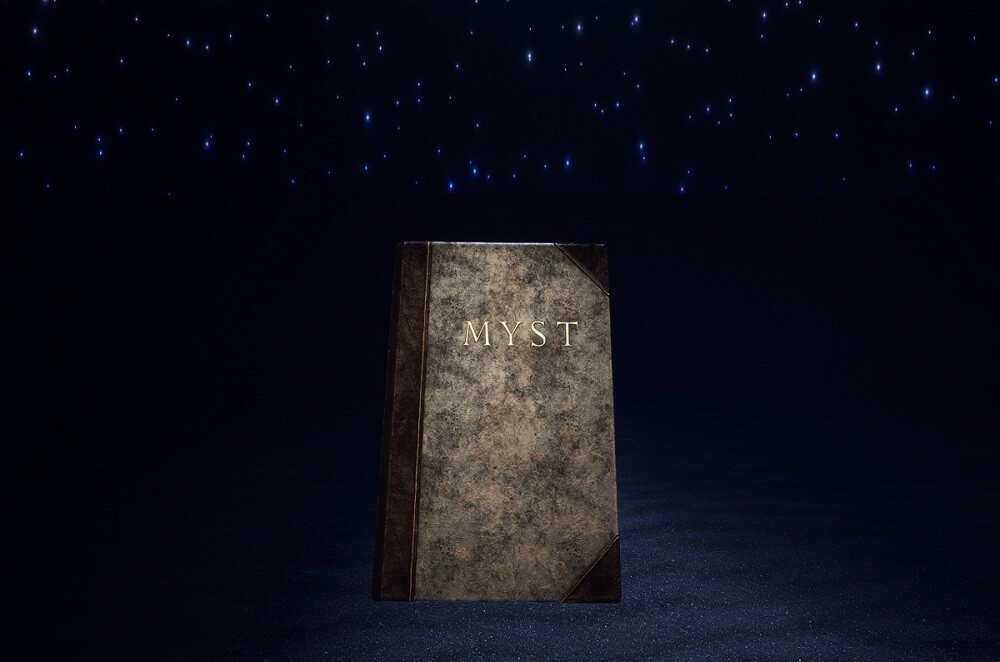

 (6 votes, average: 4.33 out of 5)
(6 votes, average: 4.33 out of 5)